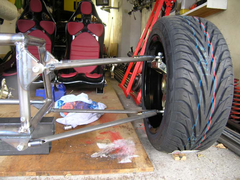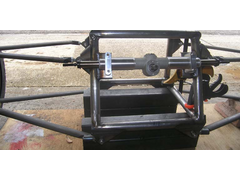
IRS Uprights - A Stupid Question?
MikeCapon - 11/2/08 at 02:56 PM
The few designs I've seen for Locost type IRS (Rorty / Chriss Gibbs) demand the fabrication of uprights. All these demand laser cutting, maching
or other capability. Which most of us don't have. Why do people not use a front upright from a FWD car using a tie rod to locate the steering
arm? It seems like an easy solution to me but have I, as is often the case, missed something?
nitram38 - 11/2/08 at 03:07 PM
I made mine for a few reasons.
One of them is having the steering rack in a better position. Mine is located in line with the top wishbones and pivot in the same place.
Another is I am using rod ends instead of ball joints so locating these in a threaded boss is easier.
Also KPI might be different to a standard roadcar because of different wheel diameter/tyre choice.


Description


Rack Mounted
[img][/img]
[Edited on 11/2/2008 by nitram38]
MikeCapon - 11/2/08 at 03:13 PM
Sorry, I was talking about using a FWD front upright as a rear upright.
nitram38 - 11/2/08 at 03:16 PM
Sorry, I should have read a little slower! 
Mr Whippy - 11/2/08 at 03:22 PM
Some folk do but as most cars these days are Macpherson strut there are not to many suitable uprights going about that you can use for double
wishbones.
MikeCapon - 11/2/08 at 03:27 PM
Surely a mushroom type adapter as used for Sierra uprights at the front would do the job?
Mr Whippy - 11/2/08 at 03:31 PM
Yip thatíll work, though I don't have a list though of all the compatible cars running gear. That would be a handy thing to have, maybe as a new
sticky topic that folk can add to when they come across one.
short track 123 - 11/2/08 at 04:03 PM
Sylva R1ot uses Mk1 or 2 Fiesta front uprights on the rear cut off the steering arms turn them upside down.
Still uses the bottom ball joint ( now on the top ) Not a very neat way of doing it but it does work.
Jason
Mr Whippy - 11/2/08 at 04:04 PM
quote:
Originally posted by short track 123
Sylva R1ot uses Mk1 or 2 Fiesta front uprights on the rear cut off the steering arms turn them upside down.
Still uses the bottom ball joint ( now on the top ) Not a very neat way of doing it but it does work.
Jason
good grief that setup must have been the product of a good night at the pub
MikeCapon - 11/2/08 at 04:07 PM
quote:
Originally posted by short track 123
Sylva R1ot uses Mk1 or 2 Fiesta front uprights on the rear cut off the steering arms turn them upside down.
Still uses the bottom ball joint ( now on the top ) Not a very neat way of doing it but it does work.
Jason
So does the Fiesta upright accept the Sierra driveshaft or does the Sierra diff accept the Fiesta driveshaft? Assuming all along that it uses a Sierra
diff!
[Edited on 11/2/08 by MikeCapon]
short track 123 - 11/2/08 at 04:08 PM
Which is why i designed and made my own.
<-------------
It uses Fiesta diff and drive shafts if you use with a bike engine that has to be moded.
Don't know about the car engine one though.
[Edited on 11/2/08 by short track 123]
James - 11/2/08 at 04:57 PM
Made my own rear uprights... completely randomly they turned out.... ahem... a little similar to the MK ones.
They need no machining. I did use a sheet metal bender at one point but they're not that hard to find. But you could do it without one of those-
just more welding and parts involved.
HTH,
James
britishtrident - 11/2/08 at 04:59 PM
Problem is getting rid of the bump steer, a fair bit of maths is needed to find the right position and length for the tie-rod and inner end usually
turns out to be in a really awkward position.
Of course it is complicated by the lack of really accurate measurements for the donor parts.
I have seen some horrors built this way.
MikeCapon - 11/2/08 at 05:19 PM
As there is no steering going on at the rear, well no rack anyway, does the bump steer thing not become simpler?
As I saw it
1 Tie rod length = Average of top and bottom wishbone lengths
2 Inboard fixing front/rear - to make tie rod parallel to wishbone centrelines
3 Inboard fixing vertical - to make tie rod at average angle of top and bottom wishbones with the suspension at mid travel.
Go on then.... I've missed something again?
short track 123 - 11/2/08 at 05:25 PM
Tie rod does not have to go back to a fixed mounting point just back to the wishbone and No bump steer.
Jason
MikeCapon - 11/2/08 at 05:38 PM
Thanks Jason,
I'll get me coat.
short track 123 - 11/2/08 at 05:47 PM
No problem..... No need for the coat....
It can be done with a fixed point but as said does take some work out.
That said there are some cars with bump steer on the rear by design.
Jason
MikeCapon - 11/2/08 at 05:55 PM
No worries Jason. Anyway SWMBO's just come back from work and I've got to put my toys away. Having thought about it I'm not at all sure
you're right. Will pick up the thread again when she's gone back to work!
blue2cv - 11/2/08 at 08:07 PM
Re drive shaft question, my build has sierra outer joints and fiesta inners, my shafts custom made by berrisfords, i had a length problem (too long to
halt the sniggerers) but splines look very similar where the tripods fit
Syd Bridge - 11/2/08 at 09:26 PM
quote:
Originally posted by short track 123
Tie rod does not have to go back to a fixed mounting point just back to the wishbone and No bump steer.
Jason
And what happens when the camber changes, as with unequal length wishbones, which seems to be the norm?
Or should that not happen?
Cheers,
Syd.
[Edited on 11/2/08 by Syd Bridge]
MikeRJ - 11/2/08 at 09:55 PM
quote:
Originally posted by Syd Bridge
And what happens when the camber changes, as with unequal length wishbones, which seems to be the norm?
I thought exactly the same. This would only ever work 100% if the steering balljoint is exactly in-line with the bottom wishbone ball joint in both
axis.
The majority of mid-engined production cars I have seen have the tie rod attached to the chassis (or becomes one of the inboard wishbone mounting
bolts in the case of the Elise). This gives a fair bit of number crunching and/or trial and error to get right, but you have the advantage that you
could design in a little toe-in on bump if required.
The other rather obvious issue with using FWD uprights is matching the CV joint that goes with the upright, to whatever diff you happen to be using.
Unless you get very lucky using production bits, it's likely that custom driveshafts will be needed.
[Edited on 11/2/08 by MikeRJ]
short track 123 - 12/2/08 at 04:44 AM
Pic
This is a standard set up on a Sylva R1ot.
You can see a proper pic's
Here
Bad 3d i know but it is 4.30 in the morning and I can not be A*$*! to do to much more to it.
As you will be able to see no bump steer due to tie rod and fixed points.
As britishtrident said if you use fixed points you will need to do some working out to get it right.
I hope this explains what i mean a little better
Jason
MikeCapon - 12/2/08 at 09:35 AM
OK Jason, I can see what you mean now.
In this particular case it was possible to pick up on the bottom wishbone as the steering arm has been cut off and effectively relocated to be on the
same axis as the bottom wishbone pivot.
In the case of a normal steering arm this will not be possible, hence the need to calculate an inboard fixing point. I stick with my original idea
except to add that the length of the tie rod should be a weighted average of the lengths of the top and bottom wishbones, weighted by the vertical
disposition of the steering arm pivot compared with the vertical positions of the top and bottom wishbone pivot points. Any comments?
MikeRJ - 12/2/08 at 10:15 AM
quote:
Originally posted by MikeCapon
I stick with my original idea except to add that the length of the tie rod should be a weighted average of the lengths of the top and bottom
wishbones, weighted by the vertical disposition of the steering arm pivot compared with the vertical positions of the top and bottom wishbone pivot
points. Any comments?
This might get you a starting point for further experimentation, but is unlikely to be the optimal position, in the same way that this doesn't
give the best position for a steering rack, because it doesn't take into account the diverging angles of wishbones.
One of the suspension CAD programs could help you out here.
short track 123 - 12/2/08 at 05:30 PM
MikeCapon Sounds like a good plan to me.
When in real terms with this type of car the wheel does not move to much so if you are some where near add in a bit of adjustment and you will be good
to play.
I suppose it just depends what you want to do with the car at the end of the day.
You could even mock it up with a sort of string computer ?
Jason
Nice sidcar out fit is it yours?
[Edited on 12/2/08 by short track 123]
MikeCapon - 13/2/08 at 07:19 AM
Thanks Jason,
Will have a play at modelling this on PC.
And, no, it's not mine. I was just the mug sat on the side 03 and 04. I can't imagine what I was thinking, getting on that thing. 225kg
210hp and bloody great big Yoko slicks. Mad.
Schrodinger - 13/2/08 at 07:35 PM
A while back I was looking to do a bulk buy of the Rorty style uprights and get them laser cut. In order to do this I needed the drawings to be put
into CAD and as I do not have the expertese I did ask on here and somebody did volunteer but as yet they have not materialised, I'm sure forgood
reasons. So if anbody wants to do the CAD bit I will be happy to see if I can get a deal on some laser cut uprights.
[Edited on 13/2/08 by Schrodinger]
short track 123 - 14/2/08 at 01:15 PM
If the interest is there I can do the cad and laser cutting. Which upright are you looking for?
If it is for the rear would a Haynes roadster type be OK
I could make up some sort of flat pack kits?
Jason





